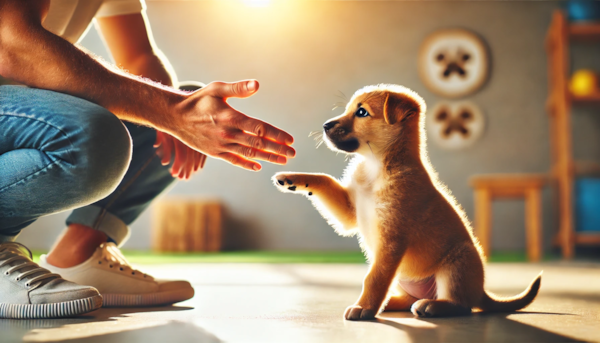
Training your dog is beneficial for many reasons including a better form of communication between you and them. It's also crucial for their safety and well-being. This article explains the 8 basic commands that form the foundation of dog training. Our experts in dog training explain how each of the 8 commands benefit both the dog and the owner and are here to provide step-by-step guidance on how to effectively teach these commands.
Table of Contents
"Sit"
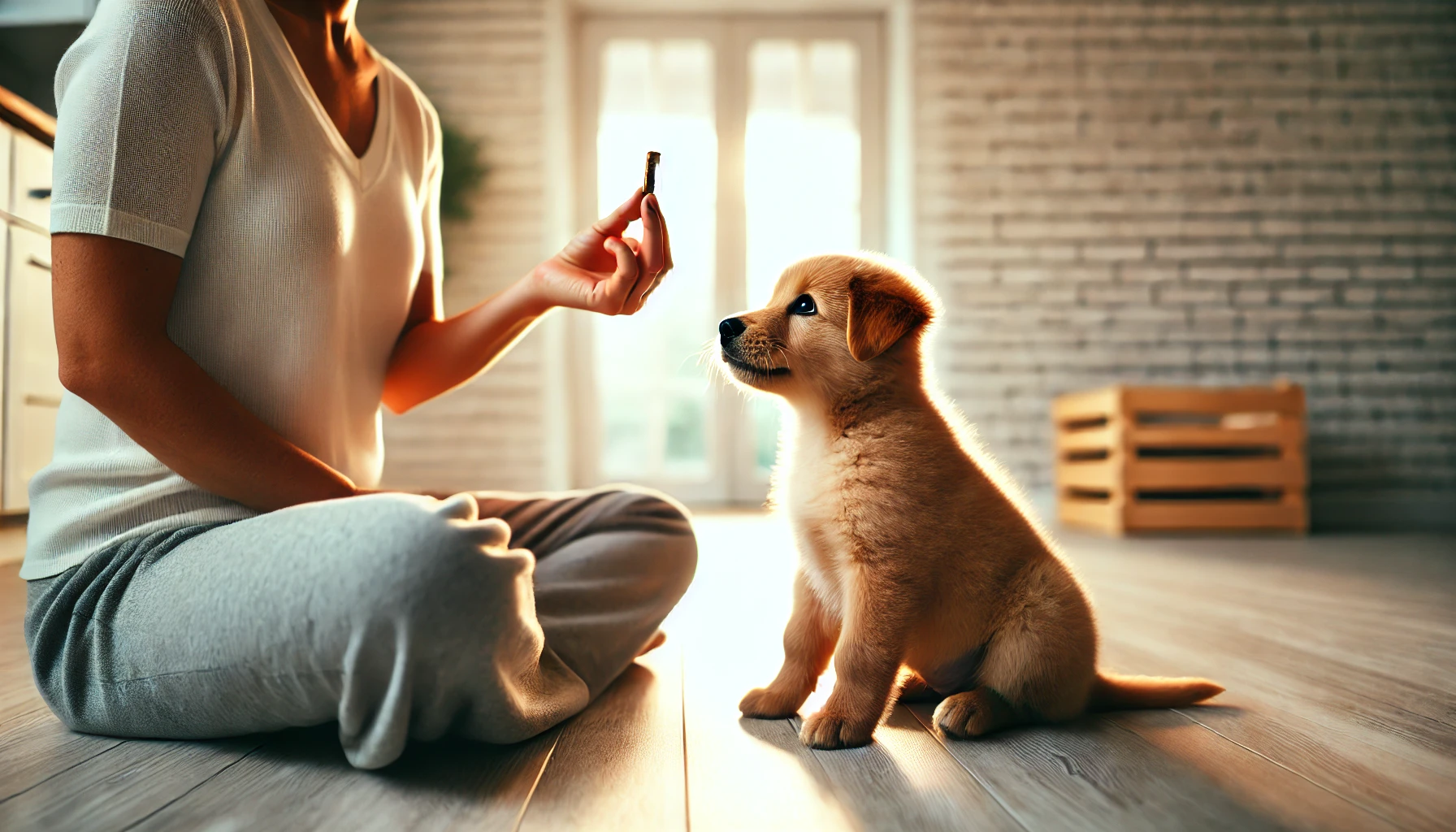
Importance and Benefits of the Command
The "Sit" command is often one of the first commands taught in basic dog training and serves as a foundation for establishing control. Teaching your dog to sit on command helps to manage their behavior in various situations, from calming excited puppies at home to maintaining discipline in public spaces. The ability to command your dog to sit also helps in building the necessary focus for more complex commands later on.
Step-by-Step Training Guide
- Choose the Right Reward: Identify a treat that your dog loves. This will be an essential motivator throughout the training process.
- Get to Your Dog’s Level: Kneel or bend down so you're closer to your dog’s height. This will make the training more engaging and less intimidating for your dog.
- Signal and Command: Hold a treat close to your dog's nose to capture their attention. Move your hand up, allowing their head to follow the treat and causing their bottom to lower. As you do this, clearly and calmly say the command "Sit." (Make sure you only say the command word once. Saying the command word multiple times before your dog acts on it, will teach them to sit only after hearing the command word multiple times).
- Reward and Praise: Once your dog’s bottom touches the ground, give them the treat and offer enthusiastic praise. This positive reinforcement helps your dog associate sitting with good outcomes.
- Repeat: Practice this command in short, frequent sessions. Consistency is key. Over time, your dog will sit with just the verbal command, without needing the hand signal or the treat.
"Stay"

Importance and Benefits of the Command
The "Stay" command is very important as it allows you to control your dog's movement and ensure their safety, especially in potentially dangerous situations. When you're at a busy street corner, in a crowded place, or you need to keep your dog still for grooming or medical examination, "Stay" is the command that helps maintain control and prevents erratic behavior. This command is particularly useful in teaching and reinforcing your dog's self-control and patience.
Techniques for Teaching Your Dog to Stay Reliably
- Start with the Basics: Ensure your dog has mastered the "Sit" command before introducing "Stay." The transition from "Sit" to "Stay" is more seamless since the dog is already in a controlled posture.
- Introduce the Command: With your dog in the sitting position, open the palm of your hand in front of you, facing your dog, and firmly say, "Stay." This visual cue helps the dog understand the expected behavior.
- Step Back: Take a step back. If your dog stays, even for just a few seconds, return immediately and reward them with a treat and praise. If they move, gently guide them back to the sitting position and repeat the command.
- Increase Duration and Distance: Gradually increase the time you ask your dog to stay and the distance you move away from them. Start with just a few seconds and a step away, then slowly build to longer periods and more steps.
- Add Distractions: Once your dog can reliably stay in a quiet environment, introduce distractions like the presence of other people or animals. This trains them to maintain the "Stay" command despite external interruptions.
RELATED: Potty Training Guide
"Down"
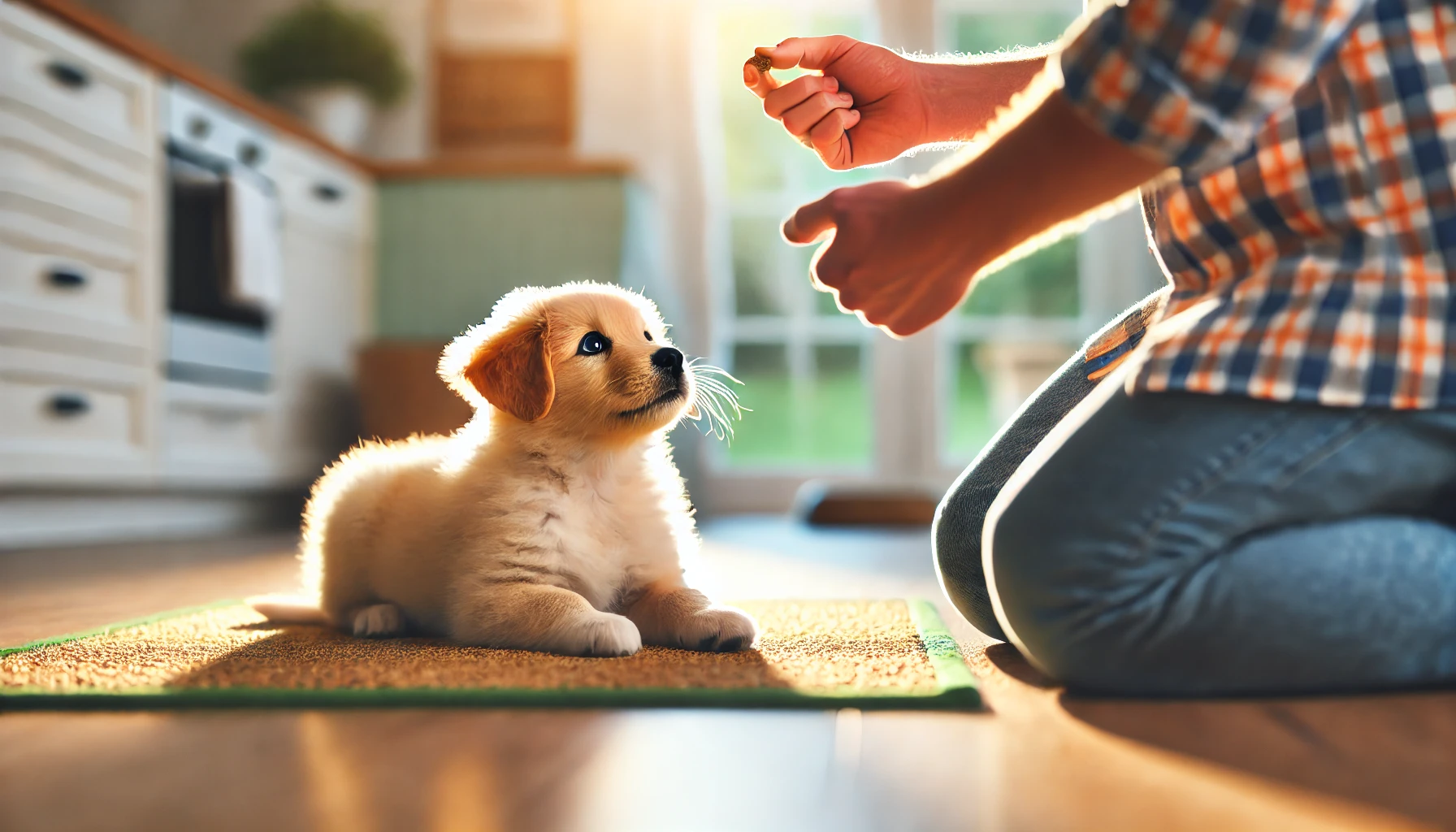
Importance and Benefits of the Command
The "Down" command is great for instilling calm behavior in your dog. It is particularly useful in reducing overexcitement and managing situations where a lower profile is necessary for safety or convenience. Teaching your dog to lie down on command can also facilitate other training activities and make it easier to manage them in public or at home.
Training Process for 'Down'
- Start in the Right Position: Have your dog begin in the sit position. This starting point makes it easier to transition into the down position.
- Use a Treat to Guide Them: Hold a treat in your hand and let your dog sniff it, but don't let them eat it right away. Slowly move your hand towards the ground, leading their head down between their paws. Your dog’s body should naturally follow their head into the down position.
- Give the Command: As you move your hand down, clearly say "Down." It’s important to give the command as they are performing the action, so they associate the word with the motion.
- Reward Immediately: Once your dog is fully lying down, give them the treat and offer plenty of praise. If your dog doesn’t follow the treat all the way down, do not force them. Instead, return to the start position and try again.
- Repeat and Extend: Practice this command frequently, and once your dog has mastered it, begin increasing the duration they remain in the down position before rewarding them.
"Come"

Importance and Benefits of the Command
The "Come" command, also known as the recall command in dog training, is arguably one of the most crucial commands a dog can learn. It is vital for their safety as it allows you to call them back to you in potentially dangerous situations, such as nearing a busy road or approaching unfamiliar animals. It's also essential for off-leash training as it ensures that your dog can enjoy freedom while still being under control and, more importantly, safe.
Training Tips for a Reliable Recall
- Start in a Distraction-Free Environment: Begin training in a quiet area to minimize distractions. You want your dog to focus solely on you.
- Use High-Value Rewards: Especially for recall, use your dog's favorite treats—ones they don’t receive at other times. The higher the reward, the more likely they are to come when called.
- Practice with a Leash or Long Line: Start with your dog on a leash or long line to ensure you can enforce the command if they don’t listen. Call your dog's name followed by the command "Come" in a clear, enthusiastic tone.
- Gradually Increase Difficulty: As your dog becomes more reliable in coming when called, gradually introduce more distractions. Practice in different settings like parks, where more interesting smells and sights exist.
- Never Punish on Arrival: If your dog takes time to come back, avoid scolding them upon their return. They must associate coming to you with positive outcomes, not negative consequences.
RELATED: Puppy Socialization Guide
"Heel"

Importance for Controlled Walking
The "Heel" command is a must for maintaining control during walks, especially in busy or potentially hazardous environments. It teaches your dog to walk calmly by your side, neither lagging behind nor pulling ahead. This command is particularly useful for managing dogs that are prone to pulling or becoming overly excited when they see other dogs or people.
How to Teach Your Dog to Heel
- Choose the Right Side: Decide whether you prefer your dog to walk on your left or right side. Consistency is key, so stick to the chosen side.
- Start with a Treat: Hold a treat in your hand on the side you want your dog to walk. Let your dog sniff the treat to gain their attention.
- Set the Pace: Begin walking and use the treat to lure your dog into the correct position at your side. As you walk, use the command "Heel" in a firm, clear voice.
- Reward Proper Positioning: When your dog walks correctly at your side, reward them with the treat and offer praise. Continue to practice in short bursts and gradually increase the walking distance before giving the treat.
- Add Distractions: As your dog becomes more proficient at heeling, introduce distractions to ensure they can maintain the behavior regardless of the environment.
RELATED: Puppy Leash Training Guide
"Leave It"

Importance of Preventing Dogs from Picking Up Dangerous Items
The "Leave It" command is critical for preventing your dog from touching or consuming harmful objects they find laying on the ground. This command is invaluable in protecting your dog from potential dangers such as toxic foods, sharp objects, or unsafe trash. It can also be useful in preventing unwanted interactions with other animals or people.
Training Methods for 'Leave It'
- Start with a Treat in Both Hands: Hold a treat in each hand. Show one closed fist with a treat inside to your dog and say "Leave it." Ignore any behaviors your dog uses to get the treat (sniffing, licking, pawing).
- Reward from the Other Hand: Once your dog stops trying to get the treat and moves their attention away from your fist, reward them with a treat from the other hand. Never give the "leave it" treat; this reinforces that leaving it means they get something better.
- Increase the Challenge: Once your dog understands they must ignore the first hand, place the treat on the floor and cover it with your hand. Repeat the command and reward your dog for ignoring the treat. Gradually increase the difficulty by uncovering the treat and using more enticing items.
- Practice in Real Situations: Apply the "Leave It" command in real-life scenarios where your dog might encounter something they should avoid. Always be ready to reinforce the command with treats from your pocket.
"Drop It"
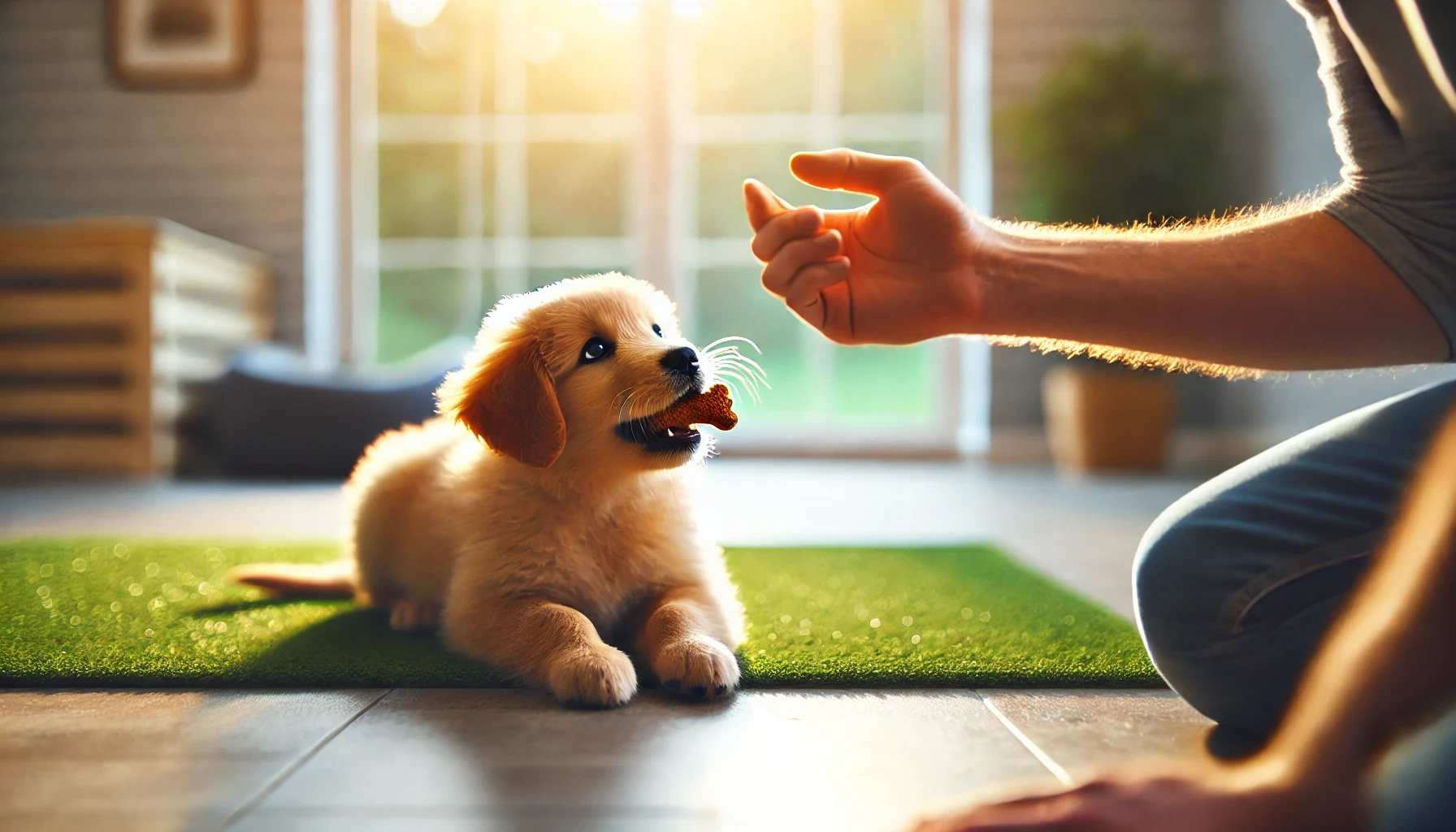
Importance in Managing Inappropriate Object Handling
The "Drop It" command is essential for ensuring your dog releases anything they should not have in their mouth—whether it's a stolen sock, a dangerous piece of debris, or an inappropriate chew toy. This command is crucial for preventing ingestion of harmful objects and for reinforcing polite play behavior.
Step-by-Step Guide to Teaching 'Drop It'
- Begin with a Low-Value Toy: Start the training with a toy that your dog likes but is not overly attached to. This reduces the challenge of having them give it up.
- Engage in Play: Start a tug-of-war game to get your dog interested in the toy. After a few moments, stop pulling and say "Drop it" while offering a high-value treat near their nose.
- Reward the Release: As soon as your dog releases the toy, give them the treat and praise them enthusiastically. It's important that the reward is more enticing than the toy.
- Repeat and Escalate: Continue practicing this command, gradually using more valued toys. Ensure the rewards always outweigh the value of what they drop.
- Apply it to Other Objects: Once your dog reliably drops toys on command, apply the command to other objects. Practice in controlled settings before expecting reliable compliance in real-world situations.
"No"

Importance of Command for Stopping Unwanted Behaviors
The "No" command is a fundamental tool in dog training. It serves as a clear, universal signal to cease any unwanted behavior immediately. This can range from discouraging jumping on guests to stopping the chewing of furniture or digging in the yard. It’s a versatile command that helps maintain order and proper behavior and it’s crucial for daily interactions and various situations.
Techniques for Enforcing the NO Command Effectively
- Clear Communication: The "No" command should be delivered in a firm, calm voice. Consistency in your tone lets your dog know that you mean business without causing fear or aggression.
- Immediate Correction: The command must be issued the moment you catch your dog in the act of unwanted behavior. Timing is critical for effective association between the behavior and the command.
- Provide Alternatives: After stopping the behavior with "No," guide your dog toward a positive alternative. For example, if they're chewing on shoes, replace the shoe with a chew toy and praise them for taking the toy.
- Consistent Reinforcement: Consistently using the "No" command for any undesirable behavior reinforces its meaning. Be patient and persistent.
- Positive Reinforcement: When your dog obeys the "No" command, follow up immediately with positive reinforcement. This could be in the form of treats, affection, or verbal praise. These will encourage them to continue obeying the command.
Conclusion
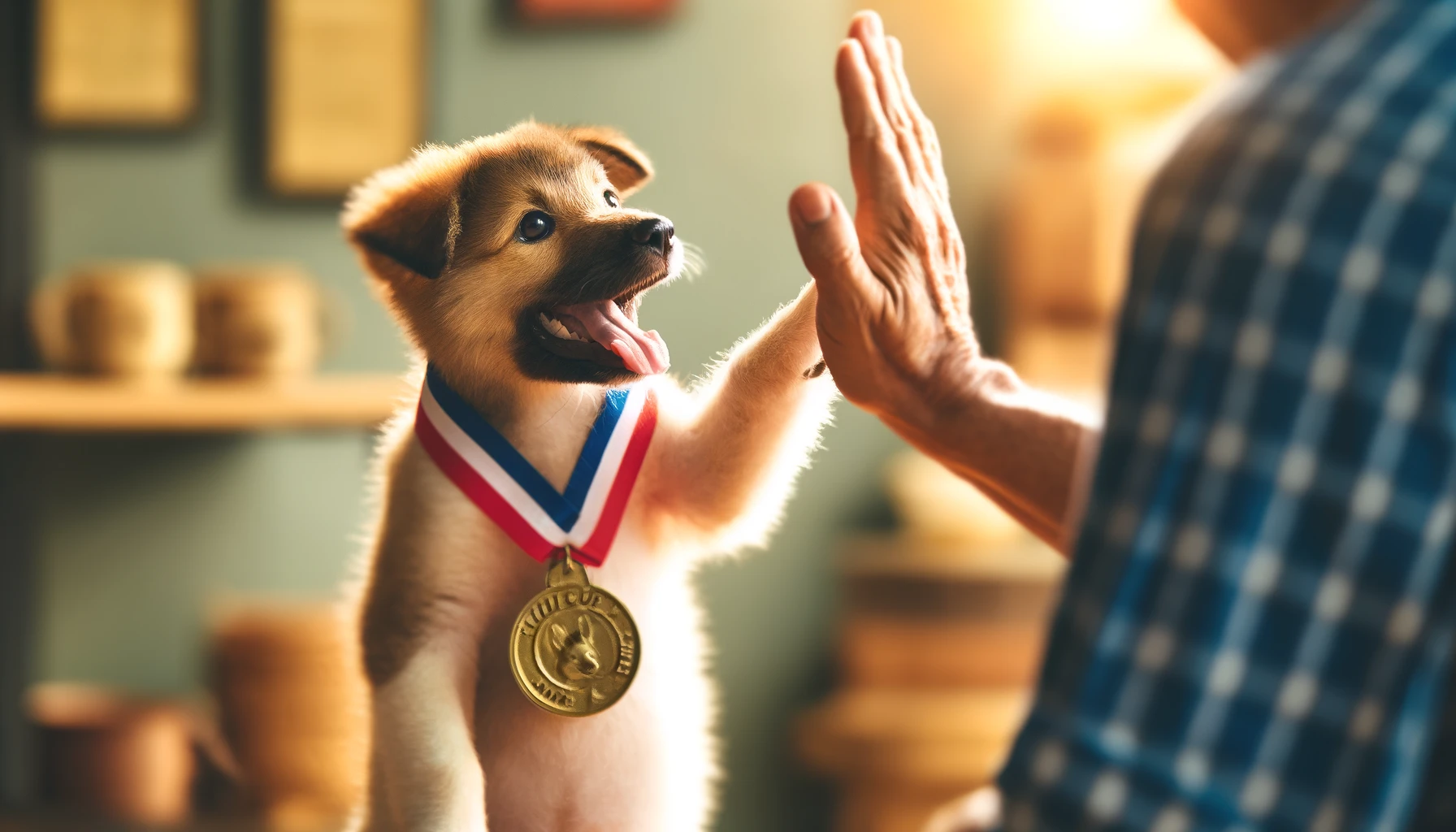
Mastering the 8 basic commands in dog training is a fundamental step towards fostering a well-behaved, obedient, and happy dog. Teaching your dog these commands—Sit, Stay, Down, Come, Heel, Leave It, Drop It, and No— not only ensures their safety but also takes the relationship you share to another level. Each command serves a specific purpose and helps manage everyday behaviors or prevent problematic situations.
Recap of the Importance and Benefits of Basic Commands
- Safety: Commands like Come and Stay can prevent your dog from getting into dangerous situations.
- Behavioral Management: Commands such as No and Leave It help curb unwanted behaviors.
- Improved Bonding: Training sessions are opportunities for you and your dog to understand each other better and strengthen the bond between you.
Consistent practice is essential for maintaining and improving your dog's response to these commands. Remember, training is not just about teaching skills, it's also about building a lasting relationship. Be patient and recognize that each small step forward is a big win in the long training journey.
Training your dog requires commitment, but the rewards of having a well-trained dog are immeasurable. Not only will you have a loyal and obedient companion, but you will also enjoy a safer, more harmonious life together. Keep practicing, stay consistent, and continue to build on the foundations you have established. Happy training!
Scroll down to see FAQs about the 8 basic commands in dog training.
What To Read Next
Puppy Training Guide for New Owners
Potty Training Guide
Frequently Asked Questions
How long does it take to teach a dog these basic commands? The time it takes to teach a dog basic commands can vary depending on the dog's age, breed, temperament, and consistency of training. Generally, a few weeks of consistent practice should help a dog learn each basic command but mastering them with distractions and in different environments may take longer.
What should I do if my dog isn't responding to commands during training sessions? If your dog isn't responding to commands, consider whether they are distracted, not motivated enough, or possibly confused by inconsistent training. Make sure you are using clear and consistent commands, providing high-value rewards, and practicing in a distraction-free environment at the beginning. Patience and consistency are key.
Is it ever too late to start training a dog? No, it's never too late to start training a dog. Older dogs can learn new commands just like puppies, although it might take a little longer since they need to unlearn old habits. The key is to be patient, keep training sessions short and enjoyable, and use positive reinforcement.
How often should I practice these commands with my dog? You should practice these commands daily to reinforce learning and improve your dog's response. Training sessions should be short, around 5 to 10 minutes each, to keep your dog's attention and prevent fatigue. Multiple short sessions spread throughout the day are more effective than one long session.
Can these commands help with behavioral problems? Yes, basic commands are very effective in managing and correcting many common behavioral problems. Commands like "Sit," "Stay," "Come," and "No" can help control behaviors such as jumping on people, running away, and excessive barking. They provide a way to communicate clearly what you expect from your dog in various situations.



